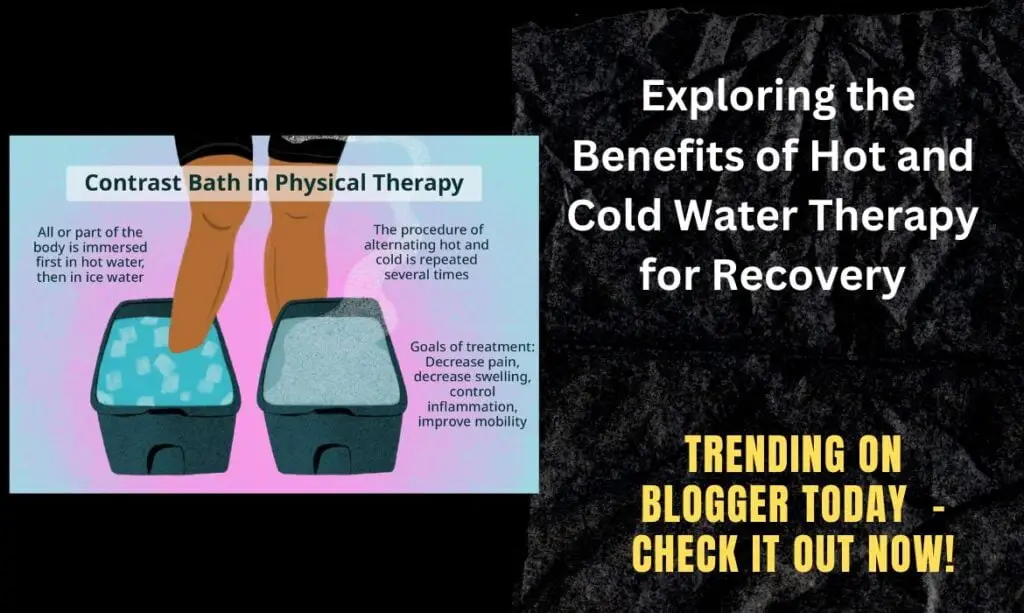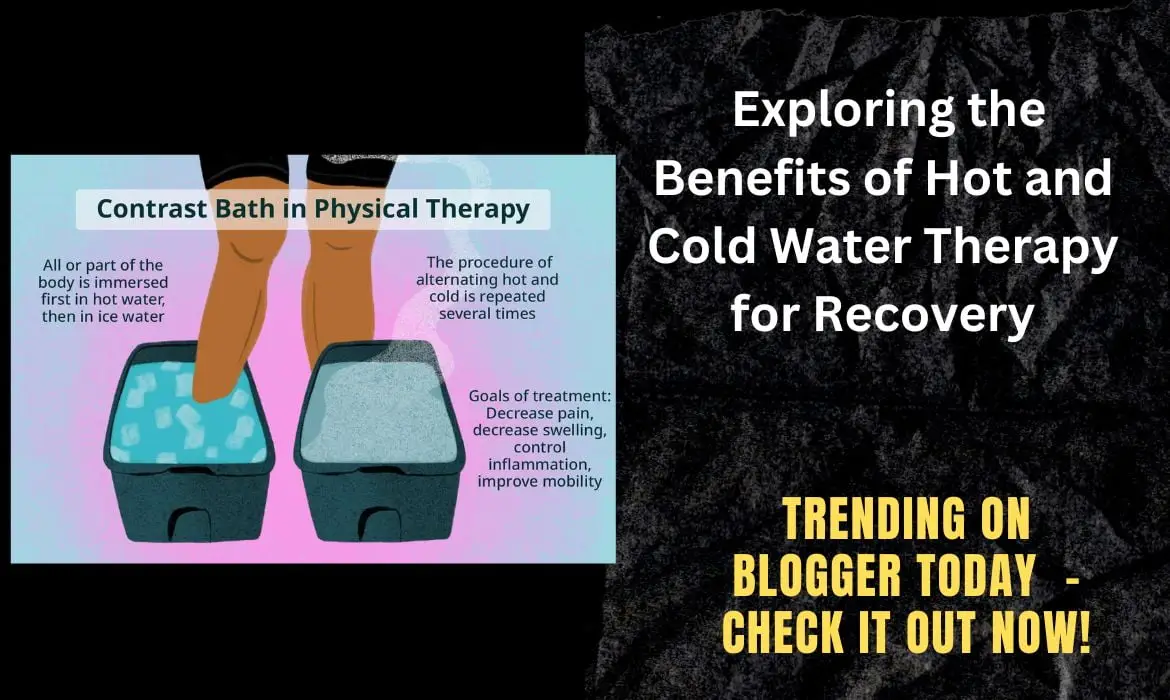I. Introduction
A. Definition of Hot and Cold Water Therapy
Hot and cold water therapy, also known as contrast hydrotherapy, is a therapeutic technique that involves the alternating use of hot and cold water to promote healing and recovery. This practice has been used for centuries, dating back to ancient civilizations that recognized the power of water in healing the body. Hot water is typically used to relax muscles and increase blood flow, while cold water is employed to reduce inflammation and numb pain.
B. Importance of Recovery in Physical Health
Recovery is a crucial aspect of maintaining physical health, especially for athletes and individuals who engage in strenuous physical activity. Proper recovery allows the body to heal, reduces the risk of injury, and prepares the muscles and tissues for future exertion. Hot and cold water therapy has gained popularity as an effective recovery method, supporting the body’s natural healing processes.
II. The Science Behind Hot and Cold Water Therapy
A. How Hot Water Therapy Works
Hot water therapy works by causing vasodilation, which is the widening of blood vessels. This increased blood flow delivers more oxygen and nutrients to muscles, promoting relaxation and reducing muscle tension. The warmth also soothes sore muscles and helps flush out toxins, making it an ideal treatment for chronic pain and stiffness.

B. How Cold Water Therapy Works
Cold water therapy, on the other hand, causes vasoconstriction, the narrowing of blood vessels. This process reduces blood flow to the affected area, minimizing inflammation and swelling. Cold water also numbs the nerves, providing immediate pain relief and helping the body recover from acute injuries or after intense exercise.
C. The Concept of Contrast Therapy (Alternating Hot and Cold)
Contrast hydrotherapy, or alternating between hot and cold water, combines the benefits of both therapies. The alternating temperatures stimulate blood circulation, improve lymphatic drainage, and accelerate the healing process. This method is particularly effective in reducing muscle soreness, enhancing flexibility, and speeding up recovery after physical exertion.
Also Read: Top Dirt Electric Bikes
III. Benefits of Hot and Cold Water Therapy for Recovery
A. Pain Relief
Hot and cold water therapy offers significant pain relief benefits. Hot water helps alleviate chronic pain by relaxing tight muscles and soothing joint discomfort. Cold water is effective for acute pain, such as injuries or post-workout soreness, by numbing the affected area and reducing inflammation.
B. Muscle Recovery
One of the most significant advantages of hot and cold water therapy is its impact on muscle recovery. By alternating temperatures, the therapy enhances blood flow, delivering essential nutrients and oxygen to the muscles while flushing out waste products. This process helps reduce muscle soreness and stiffness, allowing for quicker recovery and improved performance.
C. Inflammation and Swelling Reduction
Cold water therapy is particularly effective in reducing inflammation and swelling, which are common after injuries or intense physical activity. By constricting blood vessels, cold water limits fluid buildup and prevents further damage. Hot water, used in conjunction, promotes healing by increasing circulation and flexibility.
D. Enhanced Circulation and Detoxification
Contrast therapy significantly enhances circulation, ensuring that blood flows efficiently throughout the body. This improved circulation aids in the delivery of oxygen and nutrients to tissues, while also facilitating the removal of toxins and metabolic waste. The result is a detoxified body, better prepared for physical challenges.
E. Mental and Emotional Benefits
Beyond the physical advantages, hot and cold water therapy also offers mental and emotional benefits. Hot water therapy promotes relaxation, reducing stress and anxiety. Cold water therapy, on the other hand, can increase alertness and improve mood by stimulating the nervous system and releasing endorphins.
IV. Applications of Hot and Cold Water Therapy
A. Athletic Recovery
Athletes widely use hot and cold water therapy to speed up recovery and prevent injuries. It helps them bounce back faster from intense training sessions and reduces the risk of muscle soreness and injury.
B. Post-Injury Rehabilitation
For individuals recovering from injuries, contrast therapy is an excellent addition to rehabilitation programs. It reduces pain, decreases swelling, and promotes healing in a natural, non-invasive way.
C. Chronic Pain Management
Those suffering from chronic pain conditions like arthritis or fibromyalgia can find long-term relief through consistent use of hot and cold water therapy. The alternating temperatures provide ongoing pain management and improve quality of life.
D. Everyday Use for General Wellness
Even those not involved in intense physical activities can benefit from incorporating hot and cold water therapy into their daily routines. It enhances overall wellness by promoting circulation, reducing stress, and improving muscle and joint function.
V. Practical Tips for Implementing Hot and Cold Water Therapy
A. How to Safely Practice at Home
For those interested in trying hot and cold water therapy at home, it’s essential to follow safety guidelines. The water temperature should be comfortable, not extreme. Hot water should be between 100°F to 110°F (37°C to 43°C), and cold water should be around 50°F to 60°F (10°C to 15°C). Sessions should last no longer than 20 minutes, with 3 to 5 minutes in each temperature, alternating several times.
B. Professional Guidance
While home practice is possible, seeking professional guidance is advisable, especially for those with underlying health conditions or severe injuries. A healthcare provider can customize the therapy to meet individual needs, ensuring maximum benefits and safety.
VI. Potential Risks and Precautions
A. Contraindications
Hot and cold water therapy may not be suitable for everyone. Individuals with cardiovascular conditions, nerve damage, or skin sensitivities should consult a healthcare provider before starting the therapy.
B. Possible Side Effects
Improper use of hot and cold water therapy can lead to burns, frostbite, or exacerbation of existing conditions. It’s essential to monitor water temperatures and avoid prolonged exposure to extreme temperatures.
C. Safety Tips
To ensure a safe and effective experience, always start with mild temperatures and gradually increase or decrease the heat. Listen to your body and discontinue therapy if you experience any discomfort or adverse effects.
VII. Conclusion
A. Summary of Key Benefits
Hot and cold water therapy offers a range of benefits, from pain relief and muscle recovery to reduced inflammation and enhanced circulation. Its versatility makes it a valuable tool for anyone looking to improve their physical health and wellness.
B. Encouragement to Explore and Implement Therapy
Given its numerous advantages, hot and cold water therapy is worth exploring for those seeking natural, effective recovery methods. Whether you’re an athlete, recovering from an injury, or simply looking to enhance your overall health, this therapy can be a powerful addition to your routine.
C. Final Thoughts on the Future of Hot and Cold Water Therapy
As interest in holistic health and wellness continues to grow, hot and cold water therapy is likely to gain even more attention. Its simple yet effective approach offers a promising avenue for recovery and overall well-being.
